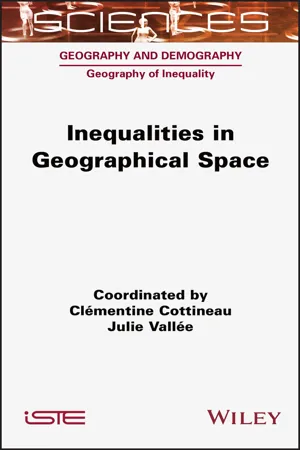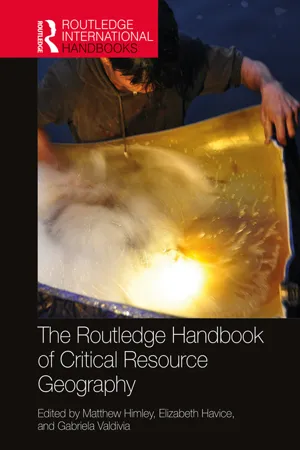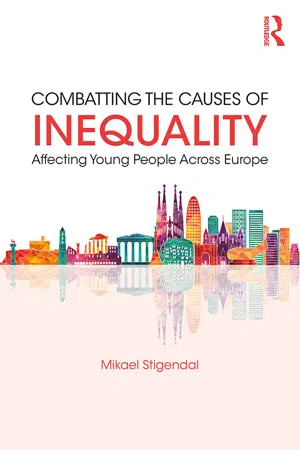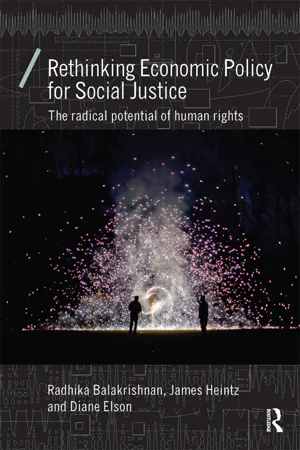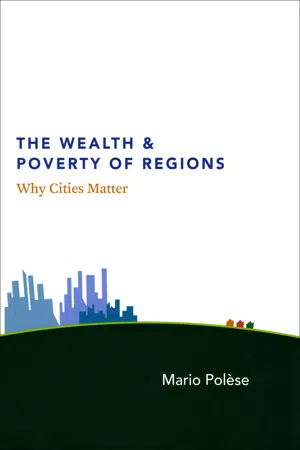Geography
Resource Inequality
Resource inequality refers to the unequal distribution of natural and human resources within a geographical area. This disparity can result from factors such as economic development, political power, and historical processes. It can lead to social and environmental challenges, including poverty, conflict, and environmental degradation. Addressing resource inequality is a key concern in geography, as it impacts the well-being of communities and the sustainability of ecosystems.
Written by Perlego with AI-assistance
Related key terms
5 Key excerpts on "Resource Inequality"
- eBook - ePub
- Clementine Cottineau, Julie Vallee(Authors)
- 2022(Publication Date)
- Wiley-ISTE(Publisher)
Chapter 4 ), which we felt were too specific and insufficiently spatialized to be included in this chapter. Here, we shall reduce the focus to the graphical, statistical and generative modeling of inequalities in geographical space.6.2. Inequality in the distribution of economic resources and in its spatial distribution
In the introduction, we defined inequality as the existence of systematic, significant and perceived differences in the distribution of social resources (e.g. wealth, health, education) between individuals because of certain characteristics (e.g. gender, age, ethnicity). These inequalities between individuals can be translated into space when privileged individuals are concentrated in certain places and disadvantaged individuals in a distinct set of places. However, these spatially translated inequalities are distinct from spatial inequalities, which would concern, for example, unequal exposure to certain nuisances or unequal access to certain resources (resulting from the distribution of facilities and services over a territory). These two types of inequalities are obviously linked to the presence of rare and valuable facilities (historical monuments, blue and green spaces, renowned hospitals) or, on the contrary, to infrastructures with negative externalities (wastewater treatment plant, motorway, cemetery) which condition the location (residential, for example) of favored or disadvantaged individuals, while modifying the potential access of populations to different resources. However, it seems more judicious to distinguish between them in the analysis in order to better understand the dynamics at work.We therefore first discuss models for describing inequalities in the distribution of economic resources (section 6.2.1 ), before detailing a method for describing inequalities in space, namely through mapping (section 6.2.2 ). Third, we evoke the models of spatial inequality and social discontinuity in space (section 6.2.3 - Matthew Himley, Elizabeth Havice, Gabriela Valdivia, Matthew Himley, Elizabeth Havice, Gabriela Valdivia(Authors)
- 2021(Publication Date)
- Routledge(Publisher)
1Critical resource geography
An introduction Gabriela Valdivia, Matthew Himley, and Elizabeth HaviceIntroduction
This Handbook is about the state of knowledge of one of geography's most cherished objects of study: resources. Resources can encompass a broad range of things, including, but not limited to, physical entities that are regularly disentangled from their existing relations and incorporated as parts or fragments within other sets of relations, in order to fulfill a promise. Resources, for example, are often thought of as means to an end, instruments to realize a goal or state, such as a life free of suffering or a “higher” level of socioeconomic development. Think of hydrocarbons extracted from the underground and refined to generate energy, or guano harvested from island ecosystems to fertilize depleted soils, or tuna captured from the oceans to meet food market demands. But resources, and the promises that they are expected to fulfill, are not simple or straightforward. Resources require systems of “resource-making” (Kama 2020; Li 2014; Richardson and Weszkalnys 2014), each with its own infrastructures, logics, temporalities, and valuation systems. Removing something from its existing relations in order to incorporate it as a resource into a new set of relations requires thought and action, all based on architectures of valuation through which some things and relations are rationalized as more valuable than others. This, in turn, raises questions about who is making these value judgments, in what context these valuations make sense and become dominant, and how systems of resource-making affect different constituencies in varied and uneven ways.The systems through which resources are made and circulated have compounding effects, shaping the world and how people experience and know it. The idea for this Handbook emerged in the context of an expansion of “critical” resource-centered scholarship examining the relationship between resource systems and the uneven worlds they create (see, for example, Bakker and Bridge 2006; Bridge 2009; Furlong and Norman 2015; Huber 2018; Lawhon and Murphy 2012; Kama 2020; Robbins 2002). Broadly, this research coheres around three key elements: an approach that positions the resource itself as the analytical starting point; an emphasis on the interrelated materiality and spatiality of resources and resource systems; and a concern for unequal power relations, distributive outcomes, and the ethical dimensions of these systems. Thematically, the focus is often on the capitalist production, distribution, and consumption of “established” resources—that is, entities whose identities as resources are relatively well-consolidated (e.g., copper, oil, tuna)—as well as the emergence of new socio-spatial “frontiers” for these, as seen, for instance, in the march of hydrocarbon and mineral-mining operations offshore and into deeper waters. Scholars also examine how an increasing array of things-in-the-world are abstracted, monetized, and incorporated into social life as “novel” resources or in resource-like ways: things such as human tissues, wildlife, parasites, and ecosystem services. Across this body of scholarship, researchers are attentive to the contestations and crises—from climate change to species extinction to toxic contamination—that are generated by dominant (i.e., capitalist) modes of resource production, consumption, management, and disposal. And scholars are increasingly interested in resource futures (e.g., green transitions and degrowth) as well as worlds that exist (or might exist) without or against the notion of resources.- Mikael Stigendal(Author)
- 2018(Publication Date)
- Routledge(Publisher)
For me, therefore, the word inequality signifies, first of all, a relation. That is part of the definition of it as a concept, i.e. the meaning of it and its content. Another word for that content is the signified. Inequality is, thus, both a signifier in the sense of a word and a signified in the sense of a concept. The signifier and the signified constitute together what I called in chapter 1.3 the reference object. In addition to these two, inequality is also that something which we refer to by using the word inequality (signifier) as a concept (signified): namely a referent object. These three aspects – the signifier, the signified and the referent – are characteristic of the philosophy of science, which this book builds on and to which I will return many times, called critical realism. There is something that may be referred to as inequality (referent object), but when we call it that, we have to make sure we define the word properly into a concept (reference object). That is what I intend to do in this chapter.Thus, inequality is a relation, comprising at least two poles, like the one mentioned by OECD Secretary General Angel Gurria between the rich and poor. I subscribe to the general definition of inequality suggested by Amartya Sen (Therborn, 2013; Sayer, 2015: 344) as part of his ‘capability approach’. On this basis, inequalities should be seen as differences, which violate the human rights of the disadvantaged (Therborn, 2013: 41). What differences can that be? This chapter answers the question by distinguishing between different types of inequality.2.1 Income and exchange-value
When differences in incomes increase to the extent that they violate the human rights of the disadvantaged, it becomes an inequality. To be poor means that you do not have sufficient resources to participate in society (Therborn, 2013: 21). As Loïc Wacquant puts it in Urban Outcasts (2008: 30), it is a “curse of being poor in the midst of a rich society in which participation in the sphere of consumption has become a sine qua non of social dignity …”. Such a difference can be understood as a particular form of inequality, called Resource Inequality. It expresses a relation between those who have and those who have not. The latter can for simplistic reasons be called the ‘have-nots’.How many young people are the have-nots in the ten Citispyce countries? What can we know about this? An indicator that measures the percentage of have-nots among young people is the at-risk-of-poverty rate. For this indicator, the population with income below a certain threshold is regarded as being at risk of poverty.2 Yet the use of it for international comparisons can be misleading, as the European Commission (2016a: 211) states, “given the differences across countries in the average age when young people leave the parental household”. It can be used, however, for comparisons with the total population in each country, as in Figure 2.1- eBook - ePub
Rethinking Economic Policy for Social Justice
The radical potential of human rights
- Radhika Balakrishnan, James Heintz, Diane Elson(Authors)
- 2016(Publication Date)
- Routledge(Publisher)
The extent of income and wealth inequality at both the national and global levels has potentially important implications for the realization of human rights. But equally important, expanding inequalities raise important questions of what is fair and just. The human rights framework, as one approach to evaluating economic and social outcomes with regard to social justice, must engage with the question of inequality—how much, if any, inequality is acceptable, and what limits does growing inequality place on the fulfillment of basic rights?Approaches to understanding inequality
When people speak of inequality, they often have in mind an unequal distribution of income or wealth. However, people experience inequalities across a number of dimensions. There are inequalities in educational attainment, in health, and in the distribution of power. The free time men and women have is unequally distributed, once all demands for work, both paid work on the job and unpaid work at home, are taken into account. Inequalities in income and wealth are associated with other disparities. For instance, low-income households have worse health outcomes on average (Subramanian and Kawachi 2004). Furthermore, inequalities can be measured with respect to different units of society—between individuals, between households, between social groups (e.g. race, gender, and ethnicity), and between countries. The emphasis in this chapter is on inequalities in income and wealth between individuals, households, social groups, and countries—and the relationship of these inequalities to human rights.Inequality can be defined in various ways and the generic term “inequality” actually reflects a range of distinct inequalities. One important distinction is between “horizontal inequality” and “vertical inequality.” Horizontal inequality is defined as inequality between culturally defined or socially constructed groups. Inequalities with respect to gender, race, ethnicity, religion, caste, and sexuality are all examples of horizontal inequalities. Vertical inequality refers to inequality between individuals or between households. The overall income or wealth distribution of an economy reflects vertical inequality, as do commonly used measurements of inequality, such as the Gini coefficient. The distinction between horizontal and vertical inequality is particularly salient when considering the human rights framework, since the issues around horizontal inequality are much more developed in discussions of economic and social rights than are issues around vertical inequality. - eBook - ePub
The Wealth and Poverty of Regions
Why Cities Matter
- Mario Polèse(Author)
- 2010(Publication Date)
- University of Chicago Press(Publisher)
4Why Is the Geography of Wealth More Unequal in Some Nations?
[T]he Industrial Revolution brought the world closer together, made it smaller and more homogenous. But the same revolution fragmented the globe by estranging winners and losers. It begat multiple worlds.DAVID S. LANDES (1998)The persistence within rich nations of significant income differences between places seems to fly in the face of basic economics. After all, if the potential for earning a living is much greater in one place, people will move there up until the moment when the difference disappears. There is much truth in this statement, but only up to a point, as we shall see. Regional income disparities are here to stay. To understand why, we need first to understand the mechanisms that caused regional inequalities to arise in the first place. What happens afterwards? Is there a predictable happy ending? Should we expect income disparities between central and peripheral places to widen or to lessen over time? The answer is not the same for all nations.On the Use of the Word DisparityNot everyone will have the same definition of what a happy ending would entail. Is it balanced growth where all regions obtain a fair share of national employment or rather a world in which welfare differences between regions will have disappeared? The two are not necessarily the same. Regional disparities can be viewed from different perspectives. Indeed, it can be argued that my use of the word disparity already betrays a bias, but I shall not go into that.1 A region can be viewed as being less prosperous because it has comparatively fewer activities or, alternatively, because its citizens are on average poorer than the rest of the nation. Although the two—size and wealth—are related, as I have repeatedly suggested, they do not necessarily
Index pages curate the most relevant extracts from our library of academic textbooks. They’ve been created using an in-house natural language model (NLM), each adding context and meaning to key research topics.
